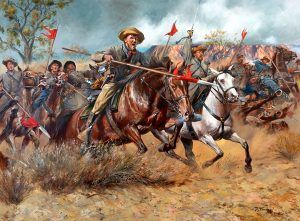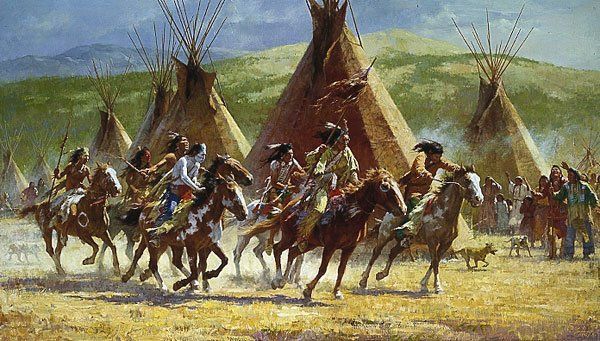
The Ghost of Crooked Creek: Unearthing a Forgotten Kansas Frontier Legend
The wind that whispers across the vast Kansas prairie today carries echoes of countless stories – tales of pioneers and warriors, of dreams built and shattered, of the relentless march of a nation westward. Many of these stories are well-worn, etched into our collective memory through textbooks and popular culture. Yet, others remain largely untold, lingering like phantoms in the dust, their truths contested, their significance often overlooked. One such spectral narrative is that of the Battle of Crooked Creek, a skirmish in May 1859 near what is now Meade County, Kansas, an event that serves as a chilling microcosm of the brutal, morally ambiguous frontier.
More than just a forgotten footnote in the annals of American expansion, Crooked Creek represents a crucial, albeit uncomfortable, piece of the mosaic that defines the legends of America. It’s a story where official reports clash with oral traditions, where heroism is interwoven with tragedy, and where the very definition of "battle" remains fiercely debated. It is a legend not of grand strategy or celebrated heroes, but of the silent, enduring conflict between narratives, a testament to how history is often written by the victors, and how the vanquished continue to seek their voice.
The Canvas of Conflict: Kansas in 1859

To understand Crooked Creek, one must first grasp the volatile environment of Kansas in the mid-19th century. This was the era of Manifest Destiny, a fervent belief in America’s divinely ordained right to expand across the continent. For the indigenous peoples who had called these lands home for millennia – the Cheyenne, Comanche, Kiowa, and others – it was an existential threat. Their traditional hunting grounds, their very way of life, were being systematically encroached upon by settlers, prospectors, and the ever-present United States Army.
Kansas, in particular, was a crucible of conflict. Still a territory, it was reeling from the internal strife of "Bleeding Kansas," where pro-slavery and anti-slavery factions had battled violently for its soul. Amidst this internal turmoil, the external pressure on Native American tribes was relentless. The military’s role was clear: to protect the westward migration, survey land, and, crucially, to "pacify" any perceived Indian resistance. It was a period marked by escalating tensions, broken treaties, and a profound cultural chasm that frequently erupted into violence.
It was into this charged atmosphere that Captain Earl Van Dorn Stuart and his detachment of the First U.S. Cavalry rode in the spring of 1859. Their mission, like many before and after, was to patrol the frontier, scout for hostile Indian parties, and ensure the safety of nascent settlements and the ever-moving wagon trains. What they found, or claimed to find, at Crooked Creek would become a stark illustration of the era’s brutal realities.
The Official Account: A Swift Victory
On May 12, 1859, Stuart’s cavalry, while on patrol near the headwaters of Crooked Creek, stumbled upon a large Cheyenne village. According to official military reports, this was a camp of "hostile" Indians, a threat to the safety and progress of the frontier. Stuart, a seasoned officer, made a swift decision: a surprise attack.
The cavalry charged at dawn, catching the sleeping village completely unawares. The attack was swift, brutal, and, from the military’s perspective, highly effective. The official accounts lauded Stuart’s decisive action and the bravery of his men. The reports detailed a fierce but short engagement, with many Cheyenne warriors killed, their lodges burned, and their horses captured. The U.S. Army suffered minimal casualties – perhaps a few wounded, but no fatalities.
Captain Stuart’s report, echoed in military dispatches of the time, painted a picture of a successful engagement against a dangerous foe. It was presented as a necessary act of defense and control, a testament to the might and efficiency of the U.S. Cavalry in securing the frontier. In the eyes of many, this was simply the hard reality of taming a wilderness and bringing civilization to the untamed West. It was a narrative of courage and justified force, fitting neatly into the prevailing ethos of the time.
The Unspoken Truth: A Massacre Remembered

But beneath the triumphant reports and the official pronouncements lay a darker, more complex truth – a truth preserved not in military archives, but in the oral traditions and collective memory of the Cheyenne people. For them, Crooked Creek was not a battle, but a brutal, unprovoked massacre.
The Cheyenne tell a different story. Their village at Crooked Creek was not a war camp, but a peaceful settlement of families, including women, children, and elders. They were simply living their lives, following the buffalo, as they had for generations. The attack was a complete surprise, a dawn raid on sleeping people. There was no "battle" in the traditional sense, but rather a slaughter of the defenseless. The high number of Cheyenne casualties, as reported even by the military, suggests a disproportionate level of violence against a non-combatant population.
From the Native American perspective, Stuart’s cavalry did not engage hostile warriors; they descended upon a vulnerable community. The burning of lodges, the killing of men, women, and children, the seizure of horses – these were not acts of war, but acts of terror and destruction. The "victory" celebrated by the U.S. Army was, for the Cheyenne, a profound trauma, another scar on a landscape already riddled with broken promises and violent encounters.
"The silence of the prairie can be deceptive," muses local historian Mark Jensen, whose research often focuses on the unwritten histories of the frontier. "It often hides the loudest stories, the ones that scream for recognition. Crooked Creek is one such scream, muffled by official reports, but never truly silenced for those who lived through its horror."
The Echoes of a Pattern: Crooked Creek in Context
The significance of Crooked Creek extends beyond its immediate tragedy. It serves as a chilling prelude, a smaller brushstroke in the grim canvas of the Plains Wars, yet it encapsulates all the tragedy and moral ambiguity of the era. It foreshadows later, more infamous massacres such as Sand Creek in 1864 and the Washita River in 1868, where similar patterns of surprise attacks on peaceful, or largely peaceful, Indian villages by the U.S. Army would unfold with devastating consequences.
As one modern historian, Dr. Evelyn Reed, noted in her work on forgotten frontier conflicts, "Crooked Creek perfectly illustrates the prevailing mindset of the time: that Native American lives were expendable, and that any gathering of Indians could be deemed ‘hostile’ enough to warrant military action, regardless of their actual intent. It was a justification for conquest, cloaked in the guise of self-defense."
The legend of Crooked Creek, therefore, is not a simple tale of good versus evil. It’s a complex narrative about the clash of civilizations, the dehumanization of an enemy, and the brutal cost of expansion. It forces us to confront uncomfortable questions about who gets to write history, whose voices are privileged, and whose suffering is minimized or erased. The "legend" itself lies in the contested ground between these narratives, in the enduring struggle to reconcile the official record with the lived experience of those who bore the brunt of frontier violence.
Searching for Reconciliation in the Dust
Today, the site of the Crooked Creek engagement remains largely unmarked, a quiet stretch of land where cattle graze and the wind rustles through tall grasses. There are no grand monuments commemorating Captain Stuart’s victory, nor are there solemn memorials to the Cheyenne lives lost. This absence, in itself, is part of the legend – a testament to how easily certain histories can be forgotten, swept under the rug of progress and national myth-making.
Yet, for those who seek to understand the full, nuanced story of America, Crooked Creek remains a vital piece of the puzzle. It challenges the simplistic narratives of westward expansion as an unmitigated triumph. It compels us to listen to the silent voices, to read between the lines of official reports, and to acknowledge the profound and lasting trauma inflicted upon indigenous communities.
The enduring legacy of Crooked Creek lies in its power to challenge our understanding of heroism and villainy, of justice and injustice. It reminds us that "legends" are not always heroic tales of glory, but can also be the haunting echoes of unaddressed wrongs, the persistent whispers of a past that refuses to stay buried. In the dust of the Kansas prairie, the ghost of Crooked Creek continues to whisper, urging us to remember, to question, and to seek a more complete and honest reckoning with our nation’s complex and often painful history. By acknowledging these forgotten stories, we don’t just learn about the past; we learn about ourselves, and perhaps, take a small step towards reconciliation with the legends that continue to shape the soul of America.


